9 Ways To Create a Pet-Friendly Home
Here at Design NJ, we obviously appreciate beautiful interiors, but we also love our pets and want them to live their best lives in our homes. Can high style coexist peacefully with our animal companions? We spoke to two pet-loving, pet-owning New Jersey designers — Michael Curren, NJCID of Curren Design Associates in Mendham and Mary Fran Brassard of Brassard Design in Rumson — who offered tips on creating a home that both you and your pet will love.
1. Use Tough Textiles
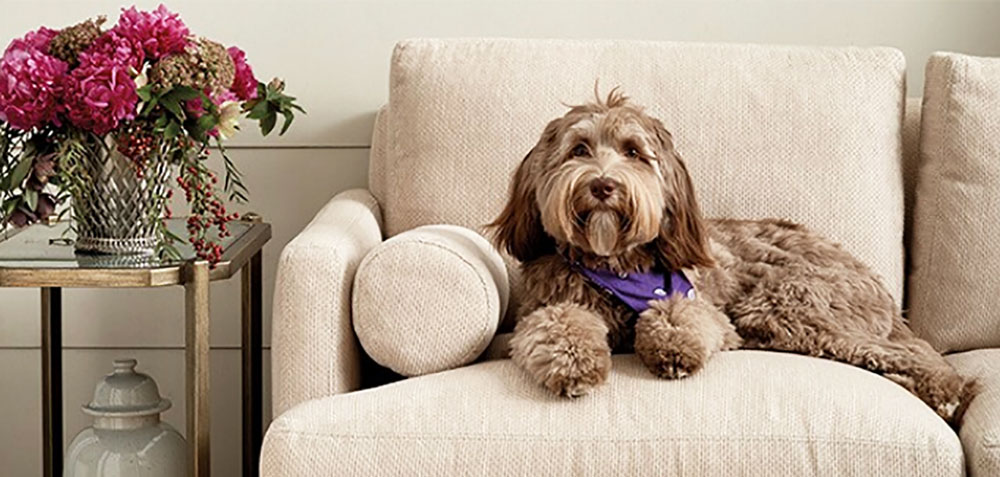
Ballard Designs offers performance fabric by Sunbrella®.
The fabrics you choose for your home need to be durable in the face of pawing pups or clawing cats (or foraging ferrets, for that matter). “There’s nothing worse, as a designer, than getting a phone call saying an animal is ruining something,” Curren says. “You can’t get mad at the animal; that’s their nature. I don’t want pets to stop being themselves because I’m worried about my furniture. In reality, they’re more important than the furniture.”
Fortunately, there’s no scarcity of hard-wearing textiles to incorporate into our homes. “The invention of performance fabric has been an unbelievable game changer,” Curren says. “These are real fabrics. They feel good. They look good. They’ve come into their own.”
Brassard agrees. “Performance fabrics are really the best for pets. They’re resist stains and repel liquids, and some are bleach-cleanable. They come in a wide variety of colors, patterns and textures.” Even certain velvets can work, Brassard notes. “Although it can be a magnet for fur, velvet is not a woven fabric. When a fabric is woven, hairs get embedded. That doesn’t happen with velvet; hair can be swept away with a brush. It does, however, have to be a performance velvet — no mohair, no chenille.”
2. Preserve & Protect

Pottery Barn offers its Pet Throw in the same fabrics as its furniture upholstery.
Sometimes it’s best to completely shield your favorite fabrics from the ravages of drooling, scratching or biting pets. “No matter how much you use performance fabrics,” Brassard says, “I also recommend adding a throw to a chair or the part of sofa that a pet favors.” You can have a pad made from your upholstery fabric to match your furniture exactly or choose a design that coordinates with your décor. “My puppy loves to snuggle up in a faux fur throw,” she says.
3. Choose Colors Carefully
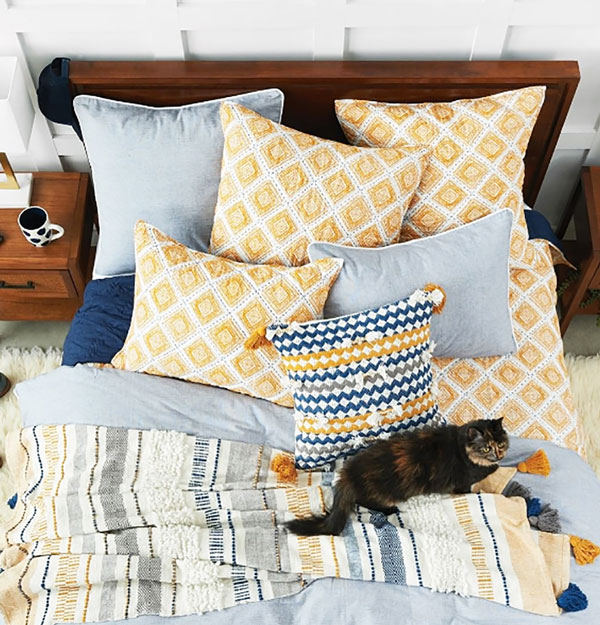
Multicolored textiles, like these from Carol & Frank, can hide a multitude of sins.
A bit of camouflage can go a long way, Curren says. “I don’t use colors or patterns that are going to show a lot of hair. Multicolored fabrics can hide a lot of that,” he says. Brassard adds, “It can even be fun to coordinate with your pet’s color” when selecting textiles. Curren concurs; he’s been known to base a design palette on a pet’s fur. “I have a client with a golden retriever and, in her home, we have worked our way through all the shades of golden retriever,” he laughs.
Brassard cautions against certain colors though. “Anything too light or too dark shows a lot of fur.” She recommends fabrics in taupe, greige, medium grays or sandstones. “Use neutrals for the things that are hard to swap out and do accessories in fun colors.”
4. Think Removable and Replaceable
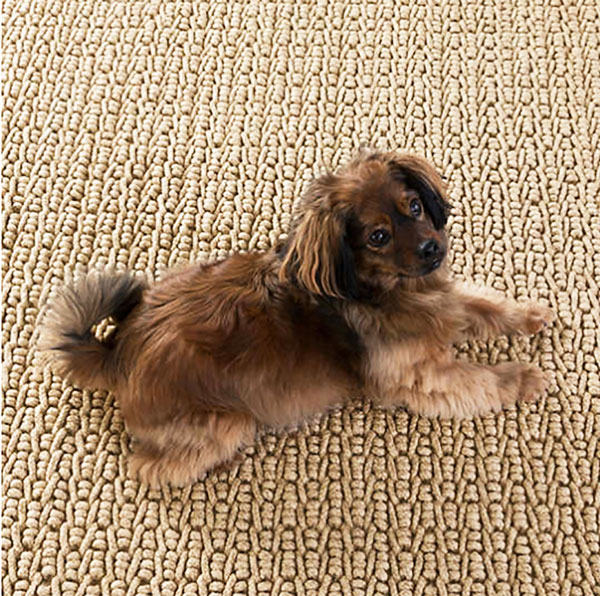
“Dash & Albert makes indoor/outdoor rugs that can be hosed down and washed,” Brassard says. Dash & Albert Veranda rug.
Decorative items that can be easily removed for cleaning — and easily replaced if need be — can be sanity savers. On floors, for instance, Brassard says “area rugs are best. They’re really popular now.” Additionally, Curren says, “they’re easier to clean around.”
Brassard notes that fabrics such as wool “clean really well, and many wool brands are planet friendly. Sisal and natural rugs don’t clean as well as wool, but they can be inexpensive or easily replaced if messed or chewed on.” She does make an exception to the “easily removable” rule for carpeting on steps. “I love to have runners on wood stairs. It keeps pets safe as they age, and it protects the wood finishes.”
5. Create a Dedicated Space
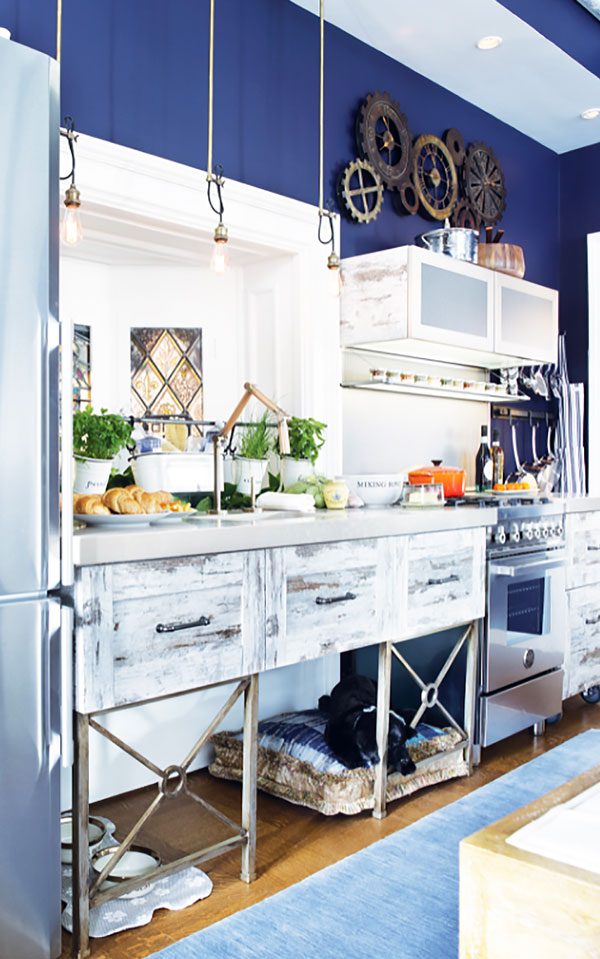
Photo: Peter Rymwid. Design NJ, October/November 2017. Design: Curren Design Associates, Plumberry Designs Inc.
Pets, like people, enjoy having a place to call their own. “We’ve taken space from under a staircase and built dog beds there,” Curren says. “Dogs, in particular, like that sort of cave-like feeling. It’s a security thing.”
Many homeowners create dedicated pet bathing stations. “If you have the luxury of having a nice mudroom, you can do a lot,” Curren says. “We’ve done showers in mudrooms that are strictly for animals. It’s easier than dragging a dog to a bathroom and putting it in the shower.” In these spaces, Curren likes to add a bit of whimsy by incorporating an animal theme into the décor. “It’s fun and people enjoy it.”
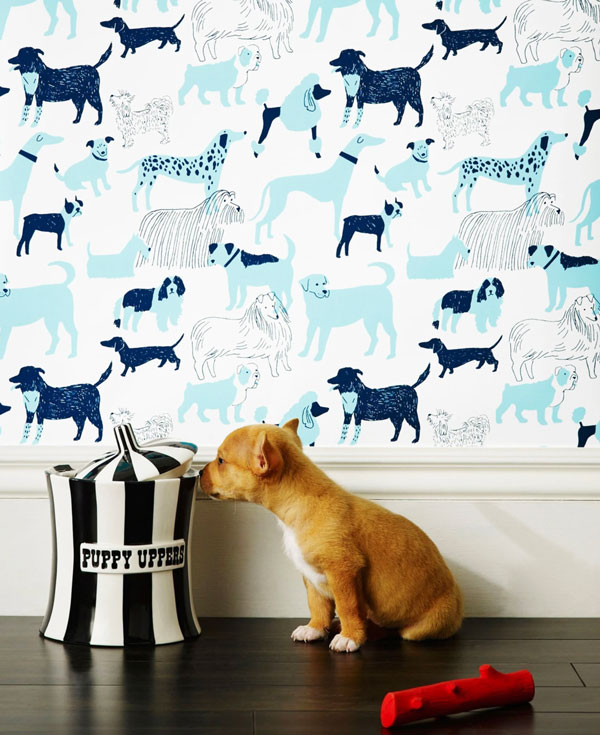
Themed decorative elements add whimsy to a pet’s space.
Julia Rothman Dog Park wallpaper from Hygge & West; canister from Jonathan Adler.
6. Consider Compromise
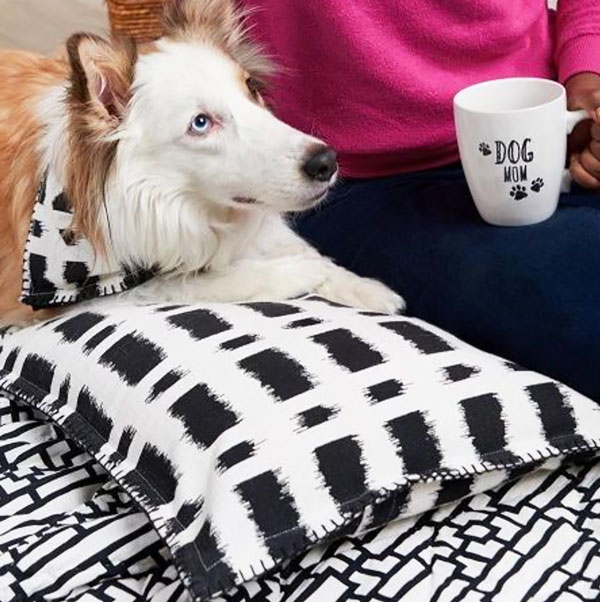
Keep breakable items, like this Tag Wholesale Dog Mom Mug, available through Carol & Frank, away from wagging tails and sniffing snouts.
Coexisting with pets, as with people, requires cooperation and concession. If you’ve got a cat who likes to play with long draperies, for example, choose your window treatments accordingly. “I’d recommend doing a shorter window treatment or no drapery at all,” Curren says. “I like to have all the light come in anyway, and the animals can perch on a windowsill and look outside.”
Keep fragile items out of the way. “Don’t ask for trouble,” Brassard says. “Keep breakable objects away from innocently wagging tails. I really watch where I put my wine glass or food.”
7. But Maintain Your Authentic Aesthetic

Bendo Cat Bowl Meow from The Design Gift Shop.
It’s not necessary to ignore your decorative preferences in favor of your pet’s needs. Pet accessories are available in a variety of styles to work with your décor. “I’m not a big fan of bowls in baseboard drawers or on the floor [she prefers them elevated in stands],” Brassard says. Still, a pet always has to have water accessible. So the designer found food bowls that complement her home. “I have a modern set in walnut to harmonize with my contemporary décor.”
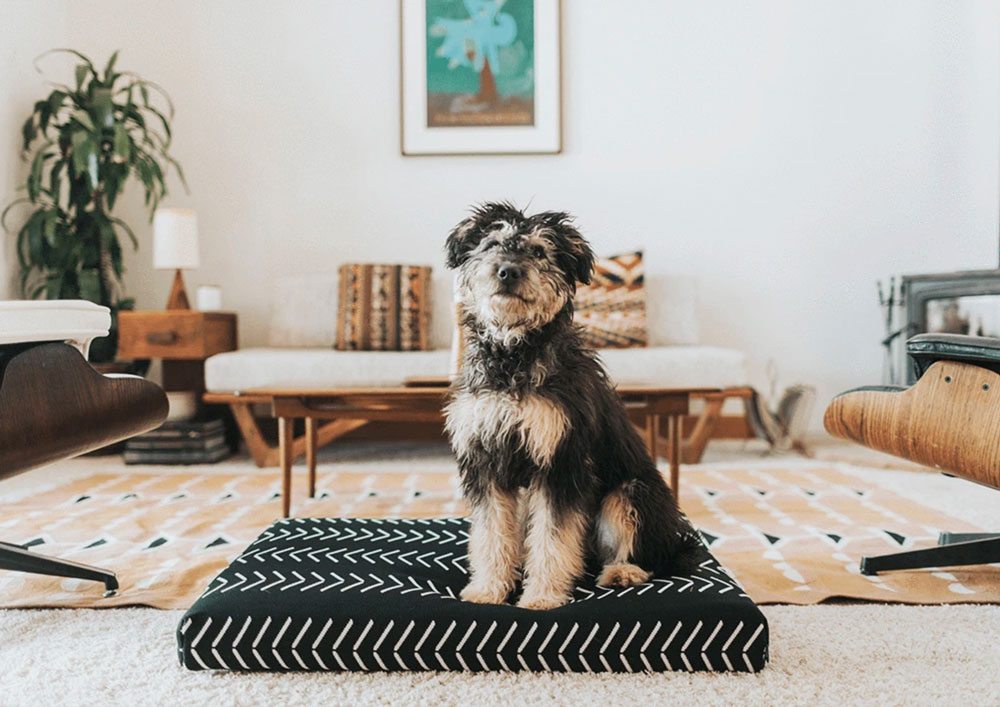
Find pet accessories that coordinate with your décor.
Laylo Pets Black Chevron Boho Dog Bed
Curren takes the same approach. “I expect my dog beds to match my room.” You can find dog beds in all sorts of styles and colors or, as Curren says, “you can send your favorite fabrics out to companies that manufacture dog beds.”
8. Contain The Clutter
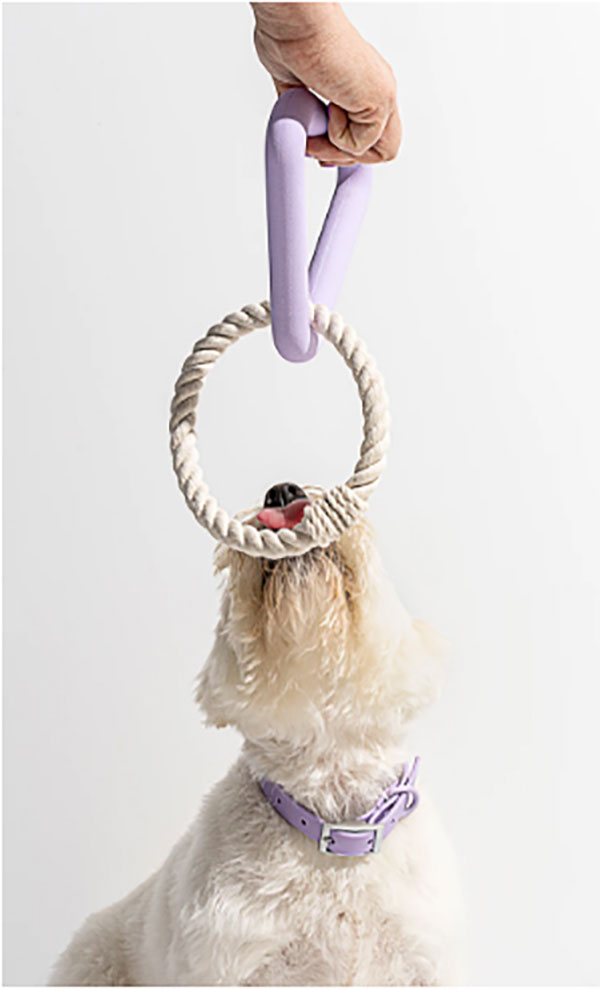
“A company called Wild One offers leashes and toys in very cool such as lilac, spruce and coral to coordinate with your home,” Brassard says.
To keep toys and leashes contained, Brassard recommends baskets. “Just like with children’s toys, they corral everything in a stylish way.” Curren has even trained his dog to return her toys to the basket when she’s through with them. “Pets are just like kids. They need a place to put their toys. Through time, they can actually learn where their toys go. We have a huge bucket under a console table. My dog puts her toys away. She’s a little obsessive, I think.”
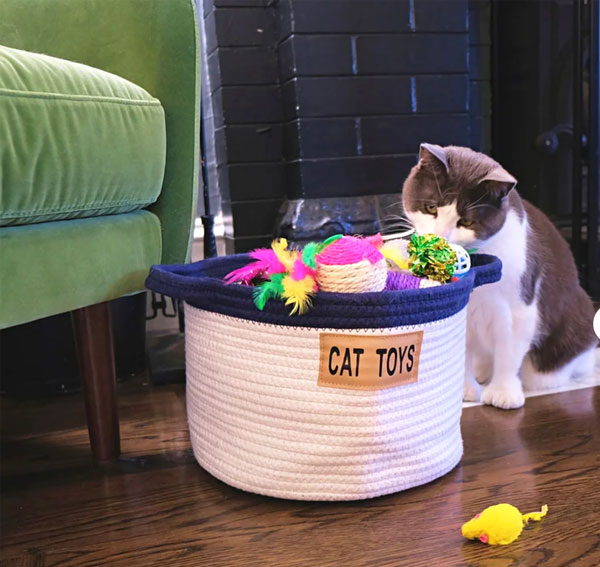
Baskets for pet toys keep clutter at bay. Tucker Murphy™ Cat Toy basket.
9. Last But Not Least: Find a Pet-Friendly Designer
Curren believes the best designer to help furnish a pet-friendly home is one who has and loves pets. “It’s easier for a designer who has a pet to understand. We talk to our clients to understand what they think about their pets. We ask questions: ‘What kind of a person are you with your pet? Is your pet allowed on the furniture? Where does your pet sleep?’ Your animals are part of your families, so treat them like it.”
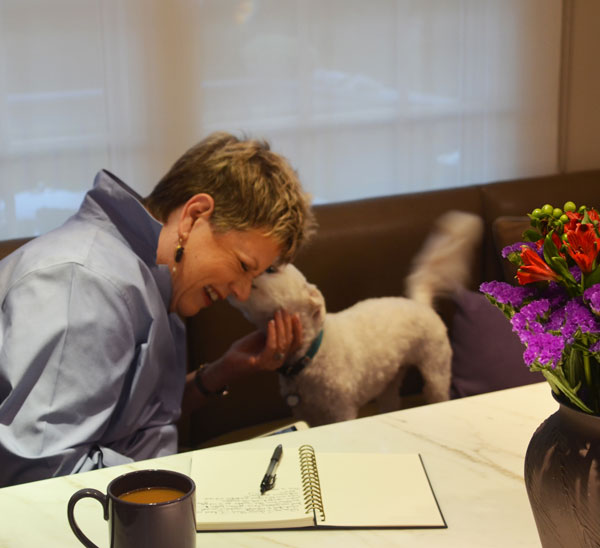
Mary Fran Brassard with Coco Chanel Colette Brassard, her Coton De Tulear. Photo by Lisa Palermo | Brassard Design | Rumson | 732-741-3773 | BrassardDesigns.com
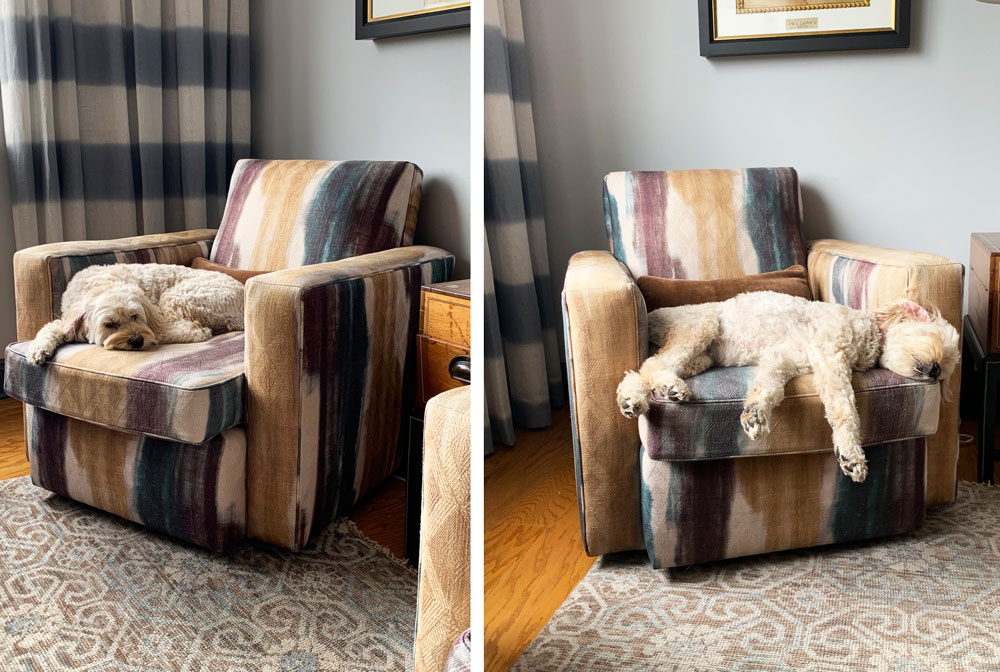
Michael Curren’s pet cockapoo, Millie, enjoying her favorite spot in the house. Curren Design Associates | Mendham | 973-543-3700 | CurrenDesign.com
